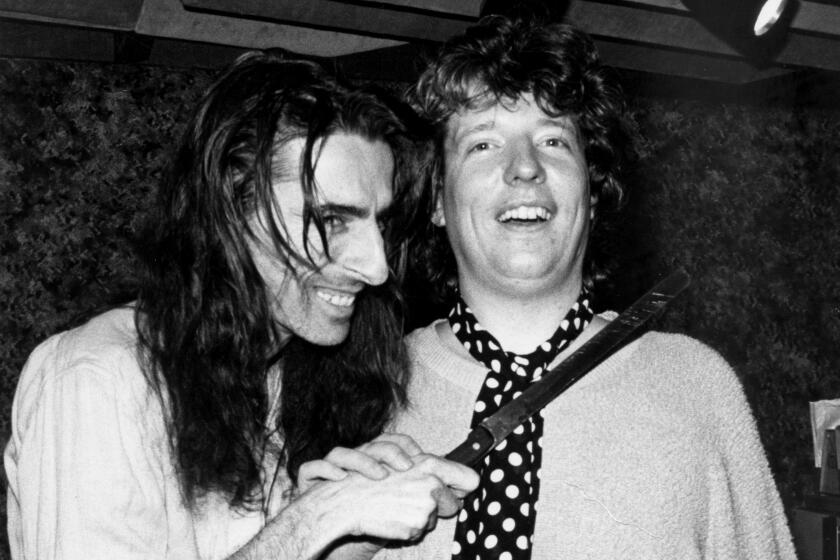Tony Verna, TV director who introduced instant replay, dies at 81
- Share via
It was the fourth quarter. Navy was beating Army, 21-7, on a grim early December day in Philadelphia.
“You’re going to do what?” announcer Lindsey Nelson asked between commercials of the college football game.
What CBS director Tony Verna wanted to do was revolutionary — use a tape machine to replay a key touchdown by Army quarterback Rollie Stichweh.
“This is not live!” Nelson would tell a nationwide audience after the commercial break. “Ladies and gentlemen, Army did not score again.”
It was the moment instant replay was born in 1963, a television milestone that would forever change the way viewers watched sports.
Verna, the visionary behind the pioneering achievement and an Emmy-winning director of five Super Bowls and 12 Kentucky Derby telecasts, died Sunday at his Palm Desert home after a short battle with acute leukemia. He was 81.
Verna’s daughter Tracy Soiseth confirmed his death.
Entertainment Weekly has listed instant replay’s debut among its 100 greatest television moments. In 2004, Sports Illustrated cited instant replay as one of sports’ “20 great tipping points” of the previous 50 years and wrote of instant replay’s impact, “The revolutionary premise was that sports could be improved not by changing the games but by changing the way they were packaged.”
Joe Starkey of the Pittsburgh Tribune-Review later called the introduction of instant replay, on Dec. 7, 1963, “the day televised football changed forever.”
Indeed, what seems automatic to viewers today was revolutionary at the time. Verna said later he had to wrangle with the news division to get the Ampex VTR-1000 from New York to Philadelphia. Full of fragile vacuum tubes and the size of a small car, the tape machine survived the 90-mile trip to Municipal Stadium in South Philadelphia, but engineers then had problems with the videotape itself.
At $300 a roll, Verna was unable to get his hands on a new roll of 3M videotape, so he was forced to use a leftover tape with an old “I Love Lucy” episode still on it. In fact, during tests earlier in the game, the rollbacks were showing flashes of Lucille Ball. Up to the pivotal replay, Verna wasn’t sure if he would get linebackers or a fluttering shot of Lucy herself.
It was both “a technical breakthrough and a conceptual one,” Sports Illustrated would note later.
Within a year, instant replay would be well on its way to becoming a staple of televised sports, virtually making the living-room recliner better than the best seat in the stadium.
The economics of that, and the billion-dollar network contracts that would follow, changed the world of sports — from viewing experiences to stadiums to salary structures.
Verna, the son of Italian immigrants, was born in Philadelphia on Nov. 26, 1933, the youngest of five in a family of photographers. He showed an early interest in large-format cameras, which led to a fascination with early television and engineering. At West Point, he quickly became disenchanted with military routine and received an early discharge after a training mission injury.
Verna then entered the University of Pennsylvania to study engineering and eventually landed a job with WFIL, the Philadelphia station that carried “American Bandstand.”
From there, he worked at other Philadelphia stations in the hurly-burly days of live television. By 1955, he was directing national baseball telecasts for CBS Sports, and his long career as one of the preeminent behind-the-scenes talents in network television had begun.
His career at CBS included the famed 1967 NFL championship game between the Green Bay Packers and the Dallas Cowboys dubbed the “Ice Bowl,” the five Super Bowls and various NBA championships and Stanley Cup finals.
Verna also co-produced and co-directed “Live Aid,” Bob Geldof’s 16-hour fundraiser for Africa, seen by 1.5 billion people worldwide in 1985.
In 1995, he received the Directors Guild of America’s Lifetime Achievement Award.
But it was instant replay for which he would always be best remembered, a game-changing development he began working on before age 30.
“If you change the way something’s been done in life, and you change how it’s done forever, I think that’s the most important thing,” he told The Times in 2008. “I changed the way things were normally done. That’s very hard to do in life.”
Yet Verna never made a dime from his innovation.
“What bothered me is that [the network] never gave me the recognition,” he told The Times. “Money’s one thing, but they never said, ‘You did it.’ This wasn’t a mushroom that came out of the ground. There wasn’t a button you could hit. Someone had to come up with it.”
Verna is survived by his wife of 46 years, Carol Verna; daughters Tracy Soiseth and Jenny Axlerod of Los Angeles; son Eric Verna of Palm Desert; and three grandchildren.
Twitter: @erskinetimes
More to Read
Start your day right
Sign up for Essential California for the L.A. Times biggest news, features and recommendations in your inbox six days a week.
You may occasionally receive promotional content from the Los Angeles Times.







